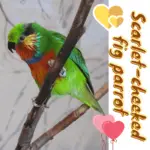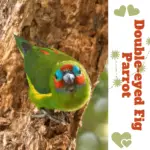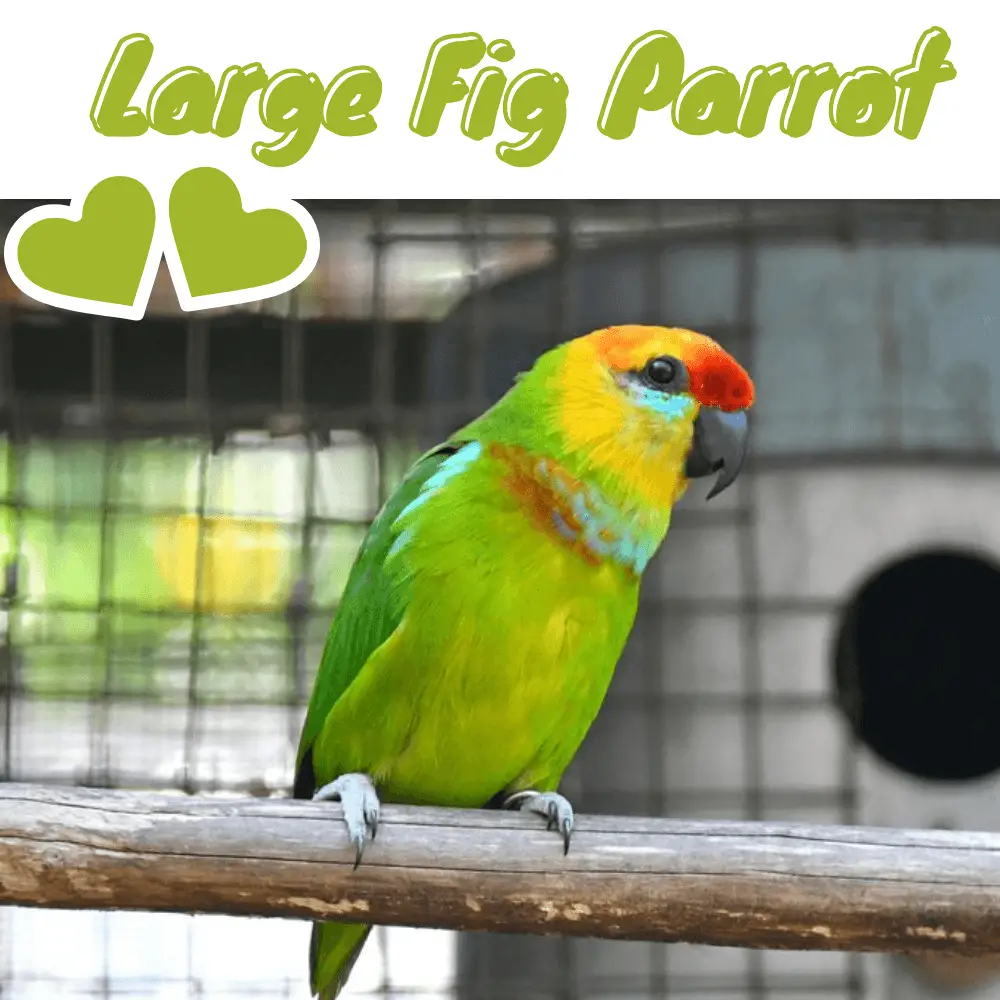Large Fig Parrot (Large) known also as flame-headed fig parrot and Desmarest’s fig parrot 18–19 cm; 108–126 g. Small, stocky, large-headed parrot, with a short spiky tail, only likely to be confused with Cyclopsitta diophthalma but the latter is smaller, lacks any breastband, and has a different face pattern.
Forehead red shading to orange on crown and nape; lores to below eye blue; face light green bordered by light blue breastband and broken orange-brown band; underparts yellowish green; back, wings and tail dull green, with innermost tertials, edged orange; underwing bar pale yellow.
Bare parts: bill black, iris dark brown, and legs and feet grey-green. Sexes alike. Immature has to crown dull yellow. Race intermedia has a more orange crown, cheeks and ear-coverts also have some orange feathers, while blue headcollar is indistinct or absent;
occidentalis deep yellow face and upper ear-coverts are elongated and deep golden-yellow, lacks blue hind collar, a rear crown is more yellowish and blue below the eye is paler than innominate; and blythii like accidental but face is brighter orange with no blue, except immatures, which possess the blue spot below the eye of other races in adult plumage.
Large Fig Parrot (Yellow-naped) 18–19 cm. Small, stocky, large-headed parrot, with a short spiky tail. Previously considered to be conspecific with P. desmarestii,
but unlike latter and P. cervicalis (also formerly treated as part of same species), P. godmani is sexually dimorphic, males having a yellow hindcollar (green in female). Differs from P. desmarestii in lack of blue below the eye (a feature shared with P. cervicalis),
brilliant golden-yellow ear-coverts and face, brighter scarlet forecrown, broader blue breastband (extending to flanks) with no or only very slight reddish band below this, and separated from P. cervicalis in lack of red face and blue on nape and hindcrown,
and paler blue breastband. Immature has a green crown (like P. cervicalis). Said to intergrade with P. cervicalis in Fly R region of SE New Guinea.
Large Fig Parrot (Red-faced) 18–19 cm. Small, stocky, large-headed parrot, with a short spiky tail, only likely to be confused with P. godman in the contact zone in CS New Guinea or with Cyclopsitta ophthalmia in far E Papua New Guinea, but latter is smaller, lacks any breastband, and has different face pattern.
Superficially also similar to male Geoffroyus geoffroyi, but the latter has a bright red bill, among other differences. Previously considered to be conspecific with P. desmarestii, but entire head appears to be orange-red, with some yellow on throat and rear ear-coverts, lacks any blue below the eye (like P. godmani)
but has a broad blue hindcollar and darker blue breastband than other taxa within this complex, it is suffused dull reddish-brown and some slight orange suffusion on rear underparts. Immature has a green crown. Said to intergrade with P. godmani in Fly R region of SE New Guinea.
Systematics History
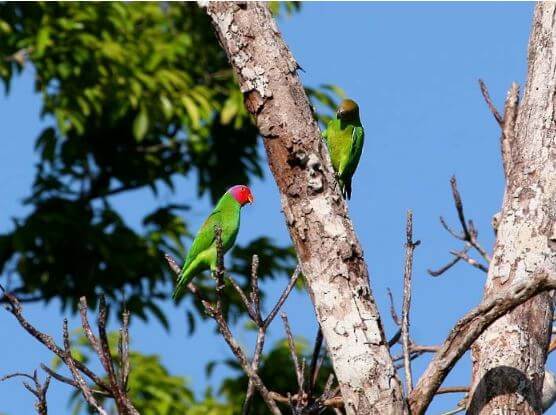
Editor’s Note: This article requires further editing work to merge existing content into the appropriate Subspecies sections. Please bear with us while this update takes place.
Large Fig Parrot (Large)
Forms a species group with P. Edwards and P. Salvadori (also including P. godman and P. cervicalis). Hitherto treated as conspecific with P. godmani and P. cervicalis. Race intermedia is often synonymized with nominate. Four subspecies were recognized.
Large Fig Parrot (Yellow-naped)
Hitherto treated as conspecific with P. desmarestii and P. cervicalis, but differs from latter in characters outlined under that species and from former in its lack of turquoise patch under eye; broad yellow mantle-band; yellow vs green face; broader turquoise breastband with no maroon below it (ns[2]). Monotypic.
Large Fig Parrot (Red-faced)
Hitherto is treated as conspecific with P. desmarestii and P. godman, but differs from both in its rich brick-red lower face and throat (continuous with crown color) vs yellow or green; royal-blue vs turquoise breastband; royal-blue of breastband extending up neck sides and forming broadband on the nape. Monotypic.
Subspecies
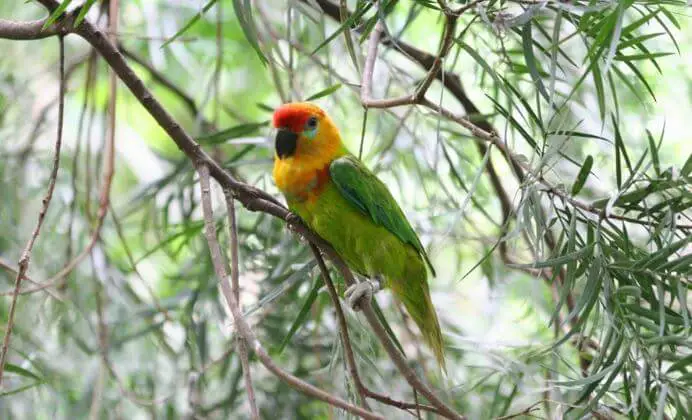
Large Fig Parrot (Large)Psittaculirostris desmarestii [desmarestii Group]
Psittaculirostris desmarestii blythii Scientific name definitions
Distribution
SUBSPECIES
Psittaculirostris desmarestii occidentalis Scientific name definitions
Distribution
Psittaculirostris desmarestii desmarestii Scientific name definitions
Distribution
Psittaculirostris desmarestii intermedius Scientific name definitions
Distribution
Large Fig Parrot (Yellow-naped)Psittaculirostris desmarestii godmani Scientific name definitions
Distribution
Large Fig Parrot (Red-faced)Psittaculirostris desmarestii cervicalis Scientific name definitions
Distribution
Distribution
Large Fig Parrot (Yellow-naped) SW & SC New Guinea E to Fly R.
Large Fig Parrot (Red-faced) Fly R E to extreme E New Guinea.
SOURCE: malaysia songbird legacy
Habitat
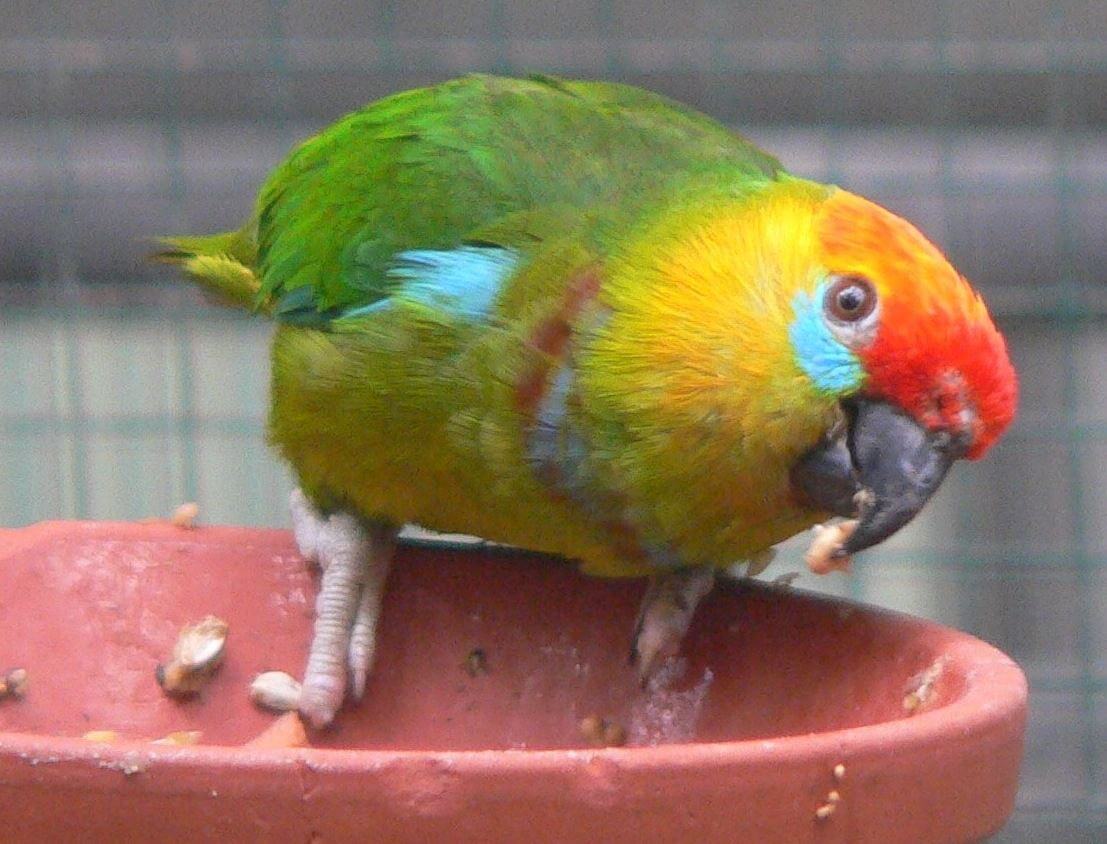
Large Fig Parrot (Large) Lowland and low hill forest, partly cleared areas, groves of casuarinas, occasionally open savanna, extending rarely up to 1650 m (usually below 1100 m).
Large Fig Parrot (Yellow-naped) No known differences from P. desmarestii, but poorly studied.
Large Fig Parrot (Red-faced) No known differences from P. desmarestii, but poorly studied.
Diet and Foraging
Large Fig Parrot (Large) Seeds of figs and partial consumption of hard pericarp of fig noted; and use of a fig species in which the fruit grows in clusters from the trunk. Forages in small groups of 2–6 birds, usually in the canopy.
Large Fig Parrot (Yellow-naped) No known differences from P. desmarestii.
Large Fig Parrot (Red-faced) No known differences from P. desmarestii.
SOURCE: obirds
Sounds and Vocal Behavior
Large Fig Parrot (Large)
Most distinctive is a thin, high-pitched downslur in flight, but also gives a sharp broken note, chattering and clicking calls, as well as a continually repeated “chet-chet” around nest-site.
Most calls are said to be louder than those of smaller lorikeets and fig-parrots, but less strident than those of Geoffroyus geoffroyi or Trchoglossus haematodus.
Large Fig Parrot (Yellow-naped)
No known differences between this species and P. Demarest, but poorly studied.
Large Fig-Parrot (Red-faced)
No known differences from P. Demarest, but poorly studied.
Breeding
Large Fig Parrot (Large)
Female in breeding condition in Jul, male in Aug, and a colony of nests being attended in Sept. Nest in cavity high in trunk or branch of a large old tree.
Large Fig Parrot (Yellow-naped)
No information, although presumably unlikely to differ substantially from very poorly known P. desmarestii.
Large Fig Parrot (Red-faced)
No information, although presumably unlikely to differ substantially from very poorly known P. desmarestii.
Conservation Status
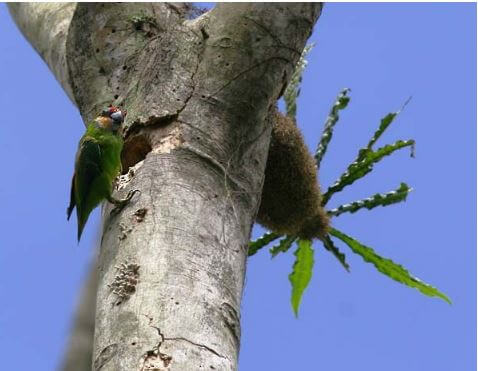
Large Fig Parrot (Large)
Not globally threatened. CITES II. Conflicting reports exist of its general abundance, but it is generally uncommon and apparently local, and intolerant of serious habitat degradation.
A total of 4475 birds (this species and P. godman combined) were exported from Indonesia in the years 1985–1990, a level of trade which has been judged possibly to place the population at risk;
commercial importation of the species into the EU from Indonesia was prohibited in Nov 1987. The overall population of this species, P. godman, and P. cervicalis combined very tentatively estimated at 150,000 birds in the late 1990s.
Large Fig Parrot (Yellow-naped)
Not globally threatened. CITES II. Generally uncommon and apparently local, and probably intolerant of serious habitat degradation.
A total of 4475 birds was exported from Indonesia (this species and P. desmarestii combined) in the years 1985–1990, a level of trade which has been judged possibly to place the population at risk; commercial importation into the EU from Indonesia was prohibited in Nov 1987.
The overall population of this species, P. desmarestii, and P. cervicalis combined very tentatively estimated at 150,000 birds in the late 1990s.
Large Fig Parrot (Red-faced)
Not globally threatened. CITES II. Generally uncommon and apparently local, and probably intolerant of serious habitat degradation, but considered to overall less at risk than western populations of P. desmarestii sensu lato (i.e. P. desmarestii and P. godmani.
The overall population of this species, P. desmarestii, and P. godman combined very tentatively estimated at 150,000 birds in the late 1990s

